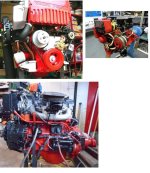Time for a new thread, with just a few questions. Promise I will be civil..
1st ? When putting it in reverse, it has a pretty good clunk. Not terrible like grinding but a clunk. Normal for the age of the boat or not?
Changed the oil in the lower last week, it was pretty black, but not milky. Also ran a magnet through the oil bucket it drained in and no metal bits came out.
2nd ? Would love to find some after market plug wires and distributor. Read quite a few things, some here, but nothing really definitive on what will work. Will plug wires for a B20 volvo work, the ends to the plugs look like the tip of the plug would be left on, currently they are not. And they wiggle quite a bit on the plug themselves.
Pretty much it, everything is running really well, as far as I can tell. I am pretty sure the tach is not working right, but that's a winter project. By running it and listening to the motor, I can tell where the sweet spot for this engine is. Valve adjustment will probably be this winter as well, can hear a ting or tick if I push it a bit. Drop it down and it goes away. Problem possibility or not?
Thanks! Jim
1st ? When putting it in reverse, it has a pretty good clunk. Not terrible like grinding but a clunk. Normal for the age of the boat or not?
Changed the oil in the lower last week, it was pretty black, but not milky. Also ran a magnet through the oil bucket it drained in and no metal bits came out.
2nd ? Would love to find some after market plug wires and distributor. Read quite a few things, some here, but nothing really definitive on what will work. Will plug wires for a B20 volvo work, the ends to the plugs look like the tip of the plug would be left on, currently they are not. And they wiggle quite a bit on the plug themselves.
Pretty much it, everything is running really well, as far as I can tell. I am pretty sure the tach is not working right, but that's a winter project. By running it and listening to the motor, I can tell where the sweet spot for this engine is. Valve adjustment will probably be this winter as well, can hear a ting or tick if I push it a bit. Drop it down and it goes away. Problem possibility or not?
Thanks! Jim


